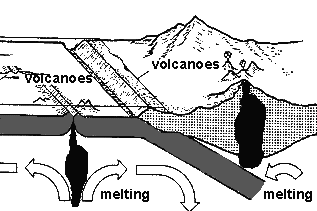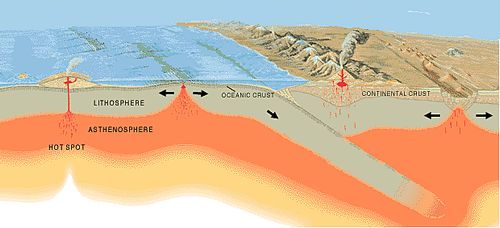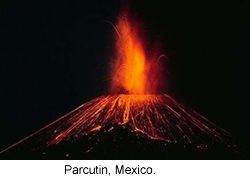BACKGROUND:
 The Plate Tectonic Cycle begins with the study of
volcanoes. Plate Tectonics is a theory developed by geologists that explains
the movements of the Earth’s crust and outer mantle. These two layers make
up the Earth lithosphere or the outer shell of solid rock. The lithosphere
is about 100 kilometers thick. Plate Tectonics also explains the origin of
many geologic phenomena, including volcanoes and earthquakes. Conversely,
the occurrence of both volcanoes and earthquakes provide data for
understanding more about Plate Tectonics. In the sixth grade labs, students
will focus on plotting data and interpreting results. The Plate Tectonic Cycle begins with the study of
volcanoes. Plate Tectonics is a theory developed by geologists that explains
the movements of the Earth’s crust and outer mantle. These two layers make
up the Earth lithosphere or the outer shell of solid rock. The lithosphere
is about 100 kilometers thick. Plate Tectonics also explains the origin of
many geologic phenomena, including volcanoes and earthquakes. Conversely,
the occurrence of both volcanoes and earthquakes provide data for
understanding more about Plate Tectonics. In the sixth grade labs, students
will focus on plotting data and interpreting results.
The theory of plate tectonics helps explain why and
where volcanoes occur. The plates move, and interact at their edges, or
boundaries. This creates melting, especially at convergent (where two plates
come together) and divergent (where two plates move apart) plate boundaries,
as shown in figure 1. . Magma is less dense than solid rock, so it will rise
towards the Earth’s surface. When it reaches the surface, it causes an
eruption.

However, some volcanic action, such as that in the
Hawaiian Islands, does not fit the plate tectonics model. Hawaii is in the
middle of the Pacific Plate, not at a plate boundary. This and other
volcanoes that occur within the plate and not at the edges (intraplate) are
probably caused by hotspots, which are magma sources in the Earth’s mantle
below the plates. Hotspot magma generation is not fully understood. In the
lab, the students will plot the locations of several volcanoes at convergent
plate boundary and intraplate settings.
We distinguish three shapes of volcanoes. First, a
shield volcano is composed of lava. The name shield describes the low, broad
structure of the volcano, like an inverted shield. The Hawaiian volcanoes
are shield volcanoes. Second, a cinder cone is a steeper structure and is
composed of cinders (or finely pulverized rock) that were explosively
erupted from the volcano. Finally, a composite volcano is composed of mixed
layers of ash and lava. Composite volcanoes are frequently much higher than
shield volcanoes, but not as steep as cinder cones. Mt. Shasta in
California, and Mt. Fuji in Japan are examples of composite volcanoes.
PROCEDURE:
- Review
with the class that earthquakes and volcanoes provide data for
geologists that can be used to interpret the Earth's processes, such as
plate movement. Have the students locate the following states and
countries on their map or globe:
 Oregon, Washington, California, Italy,
Philippines, Japan, Hawaii, Iceland, Alaska, Indonesia, Arizona,
Nicaragua, Mexico, and Chile. This will help them locate them quickly
when they complete the lab. You may want to use selected pictures
from Volcano (slideshow). Oregon, Washington, California, Italy,
Philippines, Japan, Hawaii, Iceland, Alaska, Indonesia, Arizona,
Nicaragua, Mexico, and Chile. This will help them locate them quickly
when they complete the lab. You may want to use selected pictures
from Volcano (slideshow).
- Discuss the 3 types of volcanoes by going over the
diagrams shown below. See if students can name the parts of the
volcanoes before you label them. Ask them to think about whether there
is a distribution pattern of volcanoes or do these different types occur
in the same places. In lab, they will discover there is no pattern that
can be found. Let them discover this in lab. This lab is an example
of a "null" hypothesis, a problem whose answer is no.

- Review with students the different types of
eruptions that they may have learned from previous years. The following
pictures may be helpful.
|